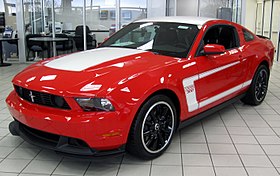Ford Mustang Boss 302
| Boss 302 Mustang | |
|---|---|
 |
|
| Overview | |
| Manufacturer | Ford |
| Production | 1969–1970 and 2012–2013 |
| Assembly |
Dearborn, Michigan (1969–1970) Flat Rock, Michigan (2012–2013) |
| Designer | Larry Shinoda |
| Body and chassis | |
| Body style | 2-door Fastback |
| Layout | FR layout |
| Related | Ford Mustang |
| Powertrain | |
| Engine | 302 CID (5.0L) Boss 302 OHV V8 (1969–1970) 5.0 L "Coyote" DOHC V8 (2012–2013) |
| Transmission | 4-speed manual (1969–1970) 6-speed manual (2012–2013) |
| 2012 Boss 302 Laguna Seca | |
|---|---|
 |
|
| Overview | |
| Production | 2012 |
| Assembly | AutoAlliance International (Flat Rock, Michigan, USA) |
| Body and chassis | |
| Body style | 2-door 2+2 sports coupe |
| Platform | 5th Generation Mustang |
| Powertrain | |
| Engine | 5.0 L V8 |
| Transmission | 6-speed manual |
| Dimensions | |
| Wheelbase | 107.1 in (2,720 mm) |
| Length | 188.1 in (4,778 mm) |
| Width | 73.9 in (1,877 mm) |
| Height | 55.1 in (1,400 mm) (Coupe) |
| Curb weight | 3,631 lb (1,647 kg) |
The Mustang boss 302 is a high-performance variant of the Ford Mustang originally produced by Ford in 1969 and 1970, alongside its more powerful sibling the Boss 429 Mustang. Ford revived the model for another two year production run in 2012 and 2013. It was produced for the Trans Am racing series.
The Camaro/Mustang rivalry had begun in 1967 with the introduction of the Chevrolet Camaro by General Motors. The Camaro was the largest threat to the lead Ford had in the "pony car" field, a market segment largely created by Ford with the introduction of the Mustang in mid-year 1964. The performance of the Mustang with 289 and 390 engines was not up to the Camaro, with its small block and big block V8. In an effort to improve the Mustang's image Ford made a 428 Cobra Jet V8 and a Ford Boss 302 engine optional for the 1968 mid-year and 1969 models, respectively. The Boss 302 C.I.D. (Hi-Po), engine was a created by combining a Ford Windsor (Assembly Plant) 302 cubic inch engine block with "large valve" Ford Cleveland (Assembly Plant) 351 cubic inch engine cylinder heads. This optional engine, and indeed the entire vehicle package, including handling and aerodynamic aids, was made available for the express purpose of meeting the homologation guidelines to compete in the SCCA Trans-Am series, which limited engine displacement to 302 C.I.D. (5.0L) in order to compete. The Boss 429 Mustang was born in a similar way, except with the intent of homologating Ford's new "semi-HEMI" 429 C.I.D. (7.0L) engine (to race in NASCAR, instead of Trans Am. The much larger engine in the Boss 429 reflects the less restrictive engine displacement limits of NASCAR at the time.
The Boss 302 Mustang was designed by Larry Shinoda, a former GM employee. The car featured a reflective "c-stripe". The fake air scoops in the rear quarter panel fenders of the regular production 1969 Mustangs were eliminated on the Boss 302 models. A black horizontal rear window shade and a blackout hood were both options. It was one of the first production models with a front spoiler and rear deck wing. The name "Boss" came about when Shinoda was asked what project he was working on, he answered "the boss's car" because the project was a secret. Also Shinoda had called it the "Boss" as an homage to the new President of Ford Semon "Bunkie" Knudson who had brought Shinoda over from GM's Chevrolet Division after Knudson had left.
...
Wikipedia
